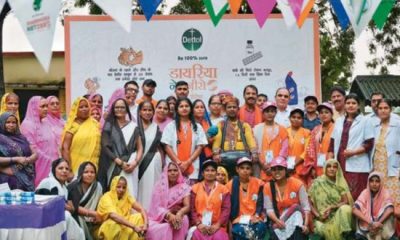New Delhi: A study conducted on public perception on air quality, found that even though the citizens are aware of the air pollution and feel sickness or discomfort due to bad air quality, there are gaps in perception on its causes and solution. The study titled “Perception Study on Air Quality” was conducted by Clean Air Collective, a network of more than 80 civil society organisations, citizen groups and experts working on the issue of air pollution across India.
Also Read: Delhiites Wake Up To Rain, Pollution Levels Drop Down To ‘Very Poor’
As many as 5,000 people were interviewed across different demographics in 17 cities to find out the level of awareness on pollution in term of the causes, effects, precautions and solutions. The study covered cities with a highly-polluted air- Delhi-NCR, Kolkata, Patna, Lucknow, Varanasi, Amritsar, Singrauli, Dhanbad, Raipur, Korba, Chandrapur, Angul, Nagpur and cities becoming rapidly polluted- Bengaluru, Pune, Mumbai and Chennai.
Across the cities, more than 90 per cent of the respondents interviewed have heard of air pollution. Delhi has the highest level of awareness and is closely followed by Chennai, Bangalore, Pune and Kolkata. Although awareness was higher in tier 1/metro cities, there are gaps in understanding of technical aspects of air pollution such as Air Quality Index (AQI), and major pollutants Particulate Matter 2.5 (PM2.5) and Particulate Matter 10 (PM10). The study finds that only 54 per cent of the respondents have an understanding about AQI, 29.6 per cent respondents knew about PM2.5 and only 17.8 per cent respondents knew about PM10.
Also Read: Children’s Day Special: Delhi’s Smog Leaves Children Gasping For Air
The study highlights that these respondents are in the age group of 18-25 years which “always” seeks information on air quality. The top two sources of AQI information for those who were aware and who understood AQI were newspapers and mobile apps, the study said. A majority of the respondents (33.4 per cent) said they accessed air quality information “sometimes” and 12 per cent said “never”. People who feel the air quality has become “much worse” belong to Angul in Odisha, Delhi-NCR, Lucknow and Patna and the people of Chennai, Raipur, Mumbai, Korba and Pune feel it has become a “little worse”, according to the study. Ronak Sutaria from Urban Sciences observed,
The awareness about air pollution in smaller/tier II cities is still not adequate. Places like Korba, Singrauli & Dhanbad which are heavily affected by air pollution are the ones where there was the least awareness about air pollution. The low awareness about the terminologies clearly reveals more thought needs to be put in while communicating about air quality.
The About 89 per cent people in Delhi felt sickness or discomfort due to the bad air quality and most of them believed that motor vehicles and felling of trees were the major causes behind pollution, the study said. The top four causes of the deteriorating air quality were identified to be motor vehicles (74 per cent), industrial units (58 per cent), tree cutting (56.9 per cent) and construction activities (48.2 per cent).
Also Read: Air Pollution Crisis: Women Boxers Wear Masks, Scarves To Guard Against Smog At World Championships In Delhi
The respondents also believe that the top three environmental issues that affect personal health are air pollution (maximum at 46.4 per cent), drinking polluted water (19.5 per cent) and global warming and climate change (12.2 per cent). “This perception needs to be addressed. It is only when people make this a priority issue will the politicians wake up and take action,” Debi Goenka, member of the Conservation Action Trust, said.
Citing a study done by Urban Emission, Clean Air Collective reiterated that on Diwali, air quality in Delhi NCR plummeted to ‘hazardous’ as PM 2.5 levels hit 999 in many parts of the city after residents flouted the Supreme Court’s 8 pm to 10 pm deadline to burst crackers and close to 5 million kgs of firecrackers were burnt in Delhi, leading to PM2.5 emissions equal to 150,000 kg mass.
Also Read: ‘Masking Our Emotions’: Farhan Akhtar & Priyanka Chopra Battle Delhi’s Pollution With Masks
Ashutosh Dikshit, CEO of URJA (United Residents Joint Action), the apex body of Delhi’s residential welfare associations (RWAs), said, “This exhaustive survey reaffirms the fact that people are aware of air pollution. However, looking at the violations on Diwali night in most parts of north India, I feel that people do not fully believe in the stated causes of air pollution and its proportionate impact. They also do not correlate air pollution as a significant contributor to their existing or future health condition. “There is a desperate need for a national-level campaign, aimed at addressing belief systems and changing behaviour,” he said.
Brikesh Singh, Chief Operations Officer of ASAR Social Impact Advisors that commissioned the study, said,
Awareness about the adverse effects of air pollution is very high, but this is not enough as most people seem to think that they need to do nothing at the individual level. Even after Supreme Court’s clear orders on firecrackers, a huge amount of crackers were burnt everywhere. Children and their parents as well burnt crackers this Diwali while wearing masks. This is what needs to be addressed. The perception of the people. Also, it is important to remember air pollution is neither Delhi specific, nor limited to winter alone.
NDTV – Dettol Banega Swachh India campaign lends support to the Government of India’s Swachh Bharat Mission (SBM). Helmed by Campaign Ambassador Amitabh Bachchan, the campaign aims to spread awareness about hygiene and sanitation, the importance of building toilets and making India open defecation free (ODF) by October 2019, a target set by Prime Minister Narendra Modi, when he launched Swachh Bharat Abhiyan in 2014. Over the years, the campaign has widened its scope to cover issues like air pollution, waste management, plastic ban, manual scavenging and menstrual hygiene. The campaign has also focused extensively on marine pollution, clean Ganga Project and rejuvenation of Yamuna, two of India’s major river bodies.






























